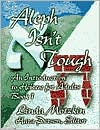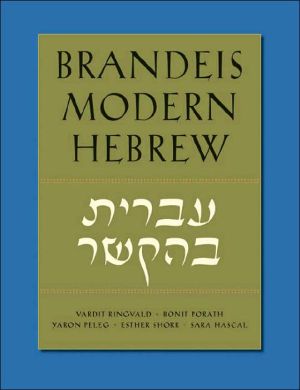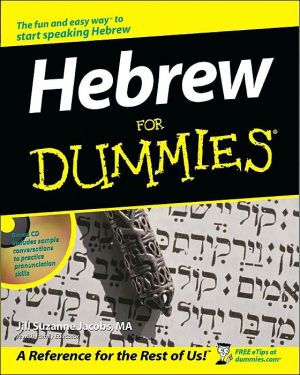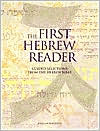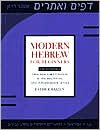The Cambridge Biblical Hebrew Workbook: Introductory Level
This workbook can be used together with any elementary Biblical Hebrew grammar. It applies many of the tools of modern language acquisition to make learning the classical language an active and inspiring process. Well-known Hebrew names are used as a pedagogical aid to memorizing grammar and vocabulary. Original Biblical texts are focused upon and the translations provided closely follow the Hebrew text. The workbook enables students to develop their understanding of systematic sound changes...
Search in google:
A comprehensive introductory workbook for students of Biblical Hebrew at colleges, seminaries and universities.
1. Hebrew alphabet; Vowel signs and their pronunciation; 2. Dissimilarity between sounds and spelling; Dagesh; Vowel letters; Silent Áleph; Diphthongs; Word stress; 3. 'Long' and 'short' vowels; Vowel categories; Full and simple vowels; Transliteration of vowels; Shva; Supporting vowels for gutterals; Relationship between consonants and vowels; Verbless clause; Independent personal pronouns in singular; 4. Syllable types; Consonant and vowel clusters; Syllable division; Qamets-/o/; Basic rule of vocalisation; 5. Relationship between vowels and stress; Unchangeable and changeable vowels; Regular vowel change; Definite article; Adjectives and nouns: inflection of gender and number; Independent personal pronouns in plural; 6. Special readings (Qere); Inseparable prepositions; Usage of adjectives; Accent signs and pause; 7. Word formation in general; Unchangeable and changeable consonants; Regular consonant change; Unchangeable and changeable root types; Inseparable prepositions followed by YHWH; 8. Conjunction and Demonstrative pronouns; Noun types; Regular masculine nouns; Regular feminine nouns; Penultimate nouns; 9. Twin-consonant nouns; Irregular nouns; Formation of nouns and adjectives; Vowel raising ('attenuation'); Existence/non-existence; Have/have not; Full and defective writing; 10. Nouns: free and bound forms; Noun chains; Adjective-plus-noun chain; Quantifier 'kol'; 11. Pronouns: attached forms; Prepositions and adverbs with 'singular' attached pronouns; Nouns in singular with attached pronouns; 12. Prepositions with 'plural' attached pronouns; Nouns in plural with attached pronouns; Questions; Sound changesacross word boundaries; More about sound changes in pause; 13. Verb system; Perfect in general: form and meaning; (Qal, the G-stem) perfect: (unchangable verbs), verbs with gutturals, Áleph verbs, the irregular verb; Vowel lowering (Philippi's Law); Verbal clause; 14. Object marker; Direction marker; Verbal clause with variant word order; Verbal clause with an additional personal pronoun; Particles-as-intensifiers; Denoting immediate presence; 15. Perfect: vav/yod (hollow) verbs, twin-consonant verbs, vav/yod verbs; Relative clauses; Usage of the verb 'be'; 16. Imperfect in general: form and meaning; Imperfect (unchangeable verbs), verbs with gutturals, Áleph verbs, the irregular verbs; 17. Imperative; Lengthened imperfect; Shortened imperfect; Negative commands and prohibitions; Particle-as-intensifier; 18. Participles in general; Participles: form, usage and negation; Participles with tense markers; Conjunctions; 19. Infinitives in general; Infinitives: form, usage and negation; Quotation marker; 20. Verb chains; Inverting-vav; Usage of verb chains; Expression of purpose and result; Perfect with attached object pronouns; 21. (The N-stem): form and meaning; Imperfect and imperative with attached object pronouns; 22. (The D- and Dp-stems): form and meaning; 23. (The HtD-stem): form and meaning; 24. (The H- and Hp-stems): form and meaning; 25. Imperfect: Áleph verbs; Imperfect, imperative and infinite: vav/yod verbs, nun verbs and vav/yod verbs; 26. 'One another' (expression of reciprocity); Verbs with two direct objects (double transitivity); Time frame; Expression of wish; Adverbs and adverbial constructions; 27. Imperfect vav/yod verbs and twin-consonant verbs; vav/yod verbs and twin consonant verbs; Oaths; 28. Numerals; Denoting age; Conditional clauses; Four styles of Biblical prose: text samples; I. Narrative texts; II. Legal texts; III. Parables and proverbs; IV. Prophetic speeches; Appendix I. Hebrew via Hebrew names; Appendix II. Regular sound changes in Hebrew; Appendix III. Guide to grammatical terms; Hebrew-English vocabulary; English-Hebrew vocabulary; Key.

